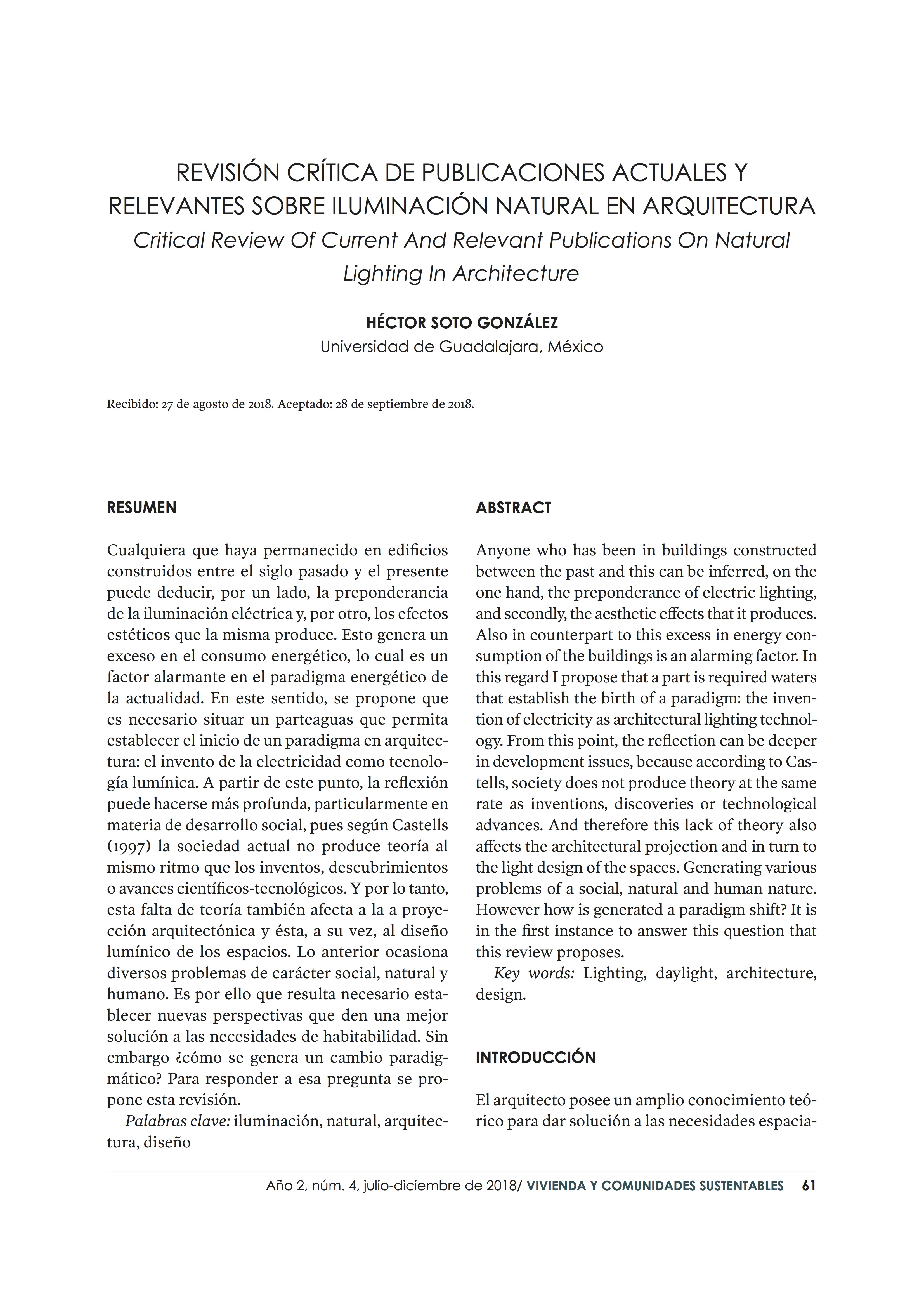Critical Review Of Current And Relevant Publications On Natural Lighting In Architecture
DOI:
https://doi.org/10.32870/rvcs.v0i4.95Keywords:
lighting, daylight, architecture, designAbstract
Anyone who has been in buildings constructed in the past and this can be inferred, on the one hand, the preponderance of electric lighting, and secondly, the aesthetic effects that it produces. Also in counterpart to this excess in energy consumption of the buildings is an alarming factor. In this regard, I propose that a part is required waters that establish the birth of a paradigm: the invention of electricity as architectural lighting technology. From this point, the reflection can be deeper in development issues, because according to Castells, society does not produce theory at the same rate as inventions, discoveries, or technological advances. And therefore this lack of theory also affects the architectural projection and in turn the light design of the spaces. Generating various problems of social, natural, and human nature. However, how is generated a paradigm shift? It is in the first instance to answer this question that this review proposes.Metrics
References
Aikenhead, G. (2005). "Educación Ciencia-Tecnología-Sociedad (CTS): una buena idea como quiera que se le llame". Educación Química, 16, 114-124.
https://doi.org/10.22201/fq.18708404e.2005.2.66121
Anderson, K. (2014). Design energy simulation for architects: Guide to 3D graphics. New York: Routledge.
https://doi.org/10.4324/9781315851433
Arteaga, A., Medellín, E. y Santos, M. J. (1995). "Dimensiones sociales del cambio tecnológico". Nueva Antropología.
Ávila Ramírez, D. C. (2015). La iluminacion natural, hacia la eficiencia energética de las edificaciones. Guadalajara: Comite Editorial de la Red de Vivienda Conacyt.
Bambardekar, S. y Poerschke, U. (2009). "The Architect As Performer of Energy Simulation in the Performance Based Design". Eleventh International IBPSA Conference, (January 2009), 1306-1313. Retrieved from http://www.ibpsa. org/proceedings/BS2009/BS09_1306_1313.pdf
Beuchot, M. (2017). Perspectivas hermenéuticas. Ciudad de México: Siglo XXl Editores.
Capanni, F. (2017). Architecure and light. Siracusa: Lettera Ventidue.
Castells, M. (1997). La era de la información: economía, sociedad y cultura; La sociedad red (Vol. I). Madrid: Alianza Editorial.
Descottes, H. y Ramos, C. E. (2011). Architectural Lighting Designing with Light and Space. New York: Pincenton Architectural Press.
Egan, M. D. y Olgyay, V. W. (2002). Architectural Lighting (Second). New York: McGraw-Hill.
Hernández Pezzi, C. (2008). Un Vitruvio ecológico, principios y practica del proyecto arquitectónico sostenible. Barcelona: Gustavo Gili.
Hetherington, R. (2013). The Integration of Architectural Design and Energy Modelling Software. The Open University.
Innes, M. (2012). Iluminación en interiorismo. Londres: BLUME.
Kuhn, T. S. (1971). La estructura de las revoluciones científicas. México D.F.: FCE.
Lam, W. M. C. (1992). Perception and Lighting as Formgivers for Architecture. New York: Van Nostrand Reinhold.Luján L., J. L. y M. (1996). "El cambio tecnológico en las ciencias sociales: el estado de la cuestión". Revista Española de Investigaciones Sociológicas, 74, 127-161.
https://doi.org/10.2307/40183888
Martín Hernández, M. J. (2001). La tarea de los arquitectos. Bansa.
Martín Monroy, M. (2006). Manual de la iluminación. Ayuntamiento de Las Palmas Gran Canaria.
Meha y, M. y Salingaros, N. (2013). "Por qué la arquitectura verde pocas veces merece su nombre". Arch Daily.
Millet, M. S. (1996). Light revealing architecture. New York: Van Nostrand Reinhold.
Norberg-Schulz, C. (1967). Intenciones en arquitectra. Oslo: Gustavo Gili.
Olgyay, V. W. (2016). Arquitectura y clima, manual de diseño bioclimático para arquitectos y urba- nistas. Barcelona: Gustavo Gili.
Plummer, H. (2014). La arquitectura de la luz natural. Barcelona: BLUME.
Teixeira, L. (2014). "Experimental study of the ocular behaviour in office workers as a visual comfort indicator in glare risk situations". International Journal on Working Conditions, 7.
Toffler, A. (1979). La tercera ola. Bogotá: Plaza & Janes S.A. Editores.
Torres, E. (2004). Luz cenital. Catalunya: CoAC. Velux Group. (2010). Daylight, Energy and Indoor Climate Basic Book. VELUX.
Wassouf, M. (2014). De la casa pasiva al estandar PASSIVHAUS. Barcelona: Gustavo Gili.

Downloads
Published
How to Cite
Issue
Section
License
Copyright (c) 2018 Vivienda y Comunidades Sustentables

This work is licensed under a Creative Commons Attribution-NonCommercial-NoDerivatives 4.0 International License.
The authors who publish in this journal accept the following conditions:
In accordance with the copyright legislation, Sustainable Housing and Communities recognizes and respects the moral right of the authors, as well as the ownership of the patrimonial right, which will be transferred to the University of Guadalajara for its dissemination in open access. Sustainable Housing and Communities does not charge authors for submitting and processing articles for publication. Authors may make other independent and additional contractual agreements for the non-exclusive distribution of the version of the article published in Sustainable Housing and Communities (for example, include it in an institutional repository or publish it in a book) as long as they clearly indicate that the work is published for the first time in Sustainable Housing and Communities.





